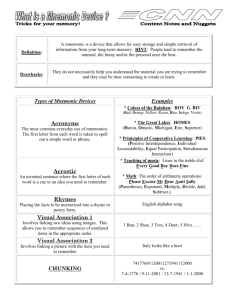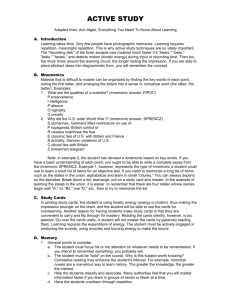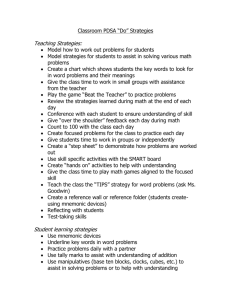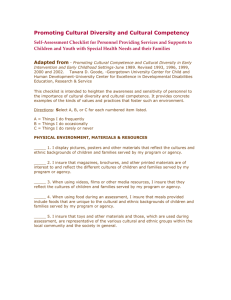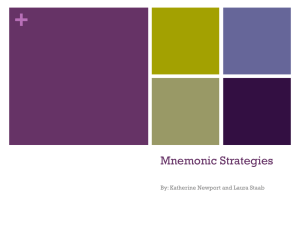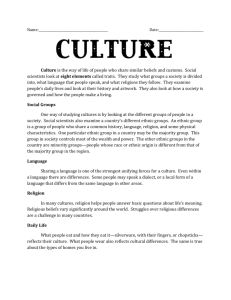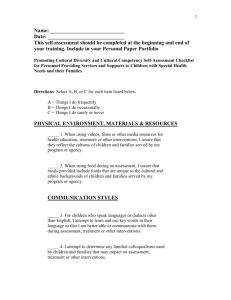Cultural Competence in Healthcare
advertisement
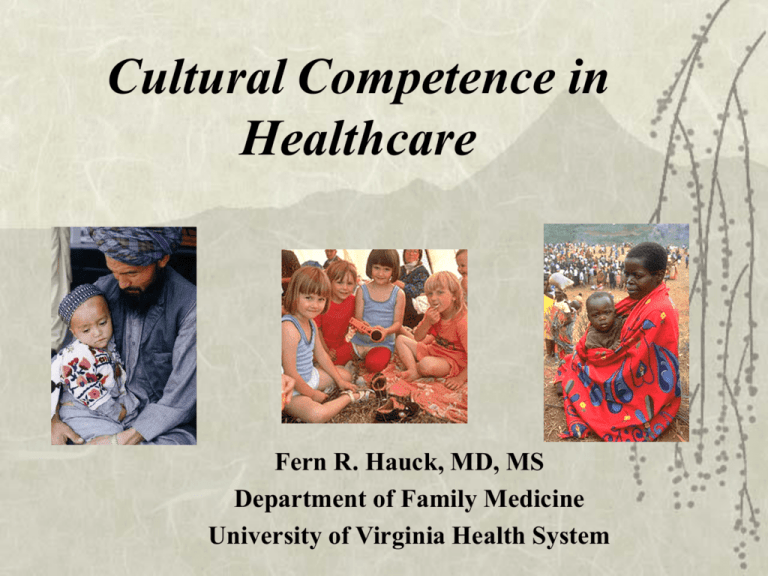
Cultural Competence in Healthcare Fern R. Hauck, MD, MS Department of Family Medicine University of Virginia Health System “I don’t think one can ever really know any but one’s own countrymen. For men and women are not only themselves; they are also the region in which they were born, the city apartment or farm in which they learned to walk, the games they played as children, the old wives’ tales they overheard, the food they ate, the schools they attended, the sports they followed, the poets they read, the god they believed in. It is all of these things that have made them what they are and these are the things that you cannot come to know by hearsay; you can only know them if you have lived them. It is all of these things that have made them what they are and these are the things that you cannot come to know by hearsay; you can only know them if you have lived them.” Somerset Maughan, The Razor’s Edge (Introduction), 1944. Definition of Cultural Competence “The knowledge and interpersonal skills that allow providers to understand, appreciate, and work with individuals from cultures other than their own. It involves an awareness and acceptance of cultural differences; self-awareness; knowledge of the patient’s culture; and adaptation of skills.” AMA, Culturally Competent Health Care for Adolescents, 1994. Culturally Competent Healthcare Systems • Interpreters or bilingual providers • Cultural diversity training for staff • Linguistically and culturally appropriate health education and information materials • Tailored healthcare settings Task Force on Community Preventive Services, 2002. Comparisons of Cultural Norms and Values Aspects of Culture Mainstream American Culture Other Cultures Communication and language Explicit, direct communication. Emphasis on content -meaning found in words. Implicit, indirect communication. Emphasis on context – meaning found around words. Time and time consciousness Linear and exact time consciousness. Value on promptness – time=money. Elastic and relative time consciousness. Time spent on enjoyment of relationships. Comparisons of Cultural Norms and Values ( continued) Aspects of Culture Mainstream American Culture Other Cultures Relationships, family, friends Focus on nuclear family. Responsibility for self. Value on youth, age seen as handicap. Focus on extended family. Loyalty and responsibility to family. Age given status and respect. Values and norms Individual orientation. Group orientation. Independence. Preference Conformity. Preference for direct confrontation of for harmony. conflict. Beliefs and attitudes Egalitarian. Challenging of authority. Individuals control their destiny. Gender equity. Hierarchical. Respect for authority and social order. Individuals accept their destiny. Different roles for men and women. Gardenswartz L, Rowe A. Managing Diversity: A Complete Desk Reference and Planning Guide, 1993. Commonwealth Fund 2001 Healthcare Quality Survey • 6,772 adults surveyed • Communication problems reported more commonly for African Americans (Af A), Hispanics (H) and Asian Americans (As A) • H and Af A adults highest uninsured rates • H and As A patients had greatest difficulty understanding information from doctor • Less than one half of limited English proficient patients always or usually had interpreters • Af A, H, and As A more often felt that they had been treated disrespectfully or with little understanding of their culture Commonwealth Fund 2001 Healthcare Quality Survey (www.cmwf.org) • Three main factors in ensuring that minority populations receive optimal medical care: Effective patient-physician communication Overcoming linguistic and cultural barriers Access to affordable health insurance • Policy implications Financing interpreters (few states only) Training of clinicians and medical students in communicating and interacting effectively with patients from different cultures Expanding health coverage and access to all Promoting Cultural Diversity and Cultural Competency Self-Assessment Checklist “Ethnic Mnemonic” E: Explanation T: Treatment H: Healers N: Negotiation I: Intervention C: Collaboration and Communication Developed by: Steven J. Levin, MD; Robert C. Like, MD; Jan E. Gottlieb, MD. Department of Family Medicine, UMDNJ-Robert Wood Johnson Medical School. “Ethnic Mnemonic” – “E” E: Explanation What do you think may be the reason you have these symptoms? What do friends, family, others say about these symptoms? Do you know anyone else who has had or who has this kind of problem? Have you heard about/read/seen it on TV/radio/newspaper? (If patient cannot offer explanation, ask what most concerns them about their problem). “Ethnic Mnemonic” – “T” T: Treatment What kinds of medicines, home remedies or other treatments have you tried for this illness? Is there anything you eat, drink, or do (or avoid) on a regular basis to stay healthy? Tell me about it. What kind of treatment are you seeking from me? “Ethnic Mnemonic” – “H” H: Healers Have you sought any advice from alternative/folk healers, friends or other people (non-doctors) for help with your problems? Tell me about it. “Ethnic Mnemonic” – “N” N: Negotiation Negotiate options that will be mutually acceptable to you and your patient and that do not contradict, but rather incorporate your patient’s beliefs. Ask what are the most important results your patient hopes to achieve from this intervention. “Ethnic Mnemonic” – “I” I: Intervention Determine an intervention with your patient. May include incorporation of alternative treatments, spirituality, and healers as well as other cultural practices (e.g. foods eaten or avoided in general, and when sick). “Ethnic Mnemonic” – “C” C: Collaboration and Communication Collaborate with the patient, family members, other health care team members, healers and community resources. Effectively use interpreters in encounters with patients with limited English proficiency. International Family Medicine Clinic International Family Medicine Clinic Goals Provide comprehensive, high quality, culturally competent care to the growing population of limited English proficiency (LEP) patients Develop systems to more efficiently care for patients, including better communication with community partners and standardized screening and evaluation Become a resource for the medical center and others who serve LEP patients Document, evaluate and advocate Current Clinic Structure 5 half-day sessions 3 clinicians Interpreters New refugee patients scheduled after Health Department Screening Special forms, cultural profiles, and database Mental health: referral to Family Stress Clinic (bilingual, volunteer counselors) International Health Intern Common Health Issues Full range of acute and chronic illnesses Infectious diseases Skin rashes Dental disease Need for eye exams and glasses Children: developmental issues Anemia/nutritional deficiencies Preventive care, e.g., Pap smears, mammograms for women Common Health Issues (2) Depression, anxiety, PTSD Medically unexplained symptoms (e.g., backaches, headaches, abdominal pain) Culturally-based syndromes Community Partners & Patients Served Refugees Immigrants Limited Visas Partners International Rescue Committee (IRC) Health Department English as a Second Language (ESL) ESL Blue Ridge Medical Center/Rural Health Outreach Project/ Lay Health Promoter Program/Wellness Passport Program ESL UVa International Studies Office Countries Middle East (Afghanistan) Eastern Europe (Bosnia-Herzegovina, Croatia) Africa (Togo, Liberia, Sudan, Congo) Somali Bantu (soon) Mexico Central and South America Other China Korea Central & South America Other Community Outreach & Collaboration ESL program/health literacy presentations and role plays Health fairs UVa Refugee and Immigrant Health Advisory Board Patient Demonstration – Part 2 All art courtesy of www.art.com
